


The annual reports are broken up into sections. Click on the tab heading to view the report section submitted by the respective section investigation leader.

California: Mike Devencenzi, Joseph Grant (UCCE), Jed Walton, Dr. Marshall Johnson (UC Riverside, outside scientist), Carolyn Pickel and Walt Bentley (UCIPM), Drs. Pete Goodell, Lucia Verela and Tunyalee Martin (UCIPM)
Oregon: Rich Garvin, Bruce Decker, Phil Van Buskirk (OSU Extension)
Washington: Dan Flick, Nick Stephens, Karen Lewis (WSU Extension), Dr. Doug Walsh (WSU, outside scientist)
Canada: Dr. Gary Judd (Agriculture and Agri-Food Canada, outside scientist)
Our project has just finished the third year of five and we are actively moving into the outreach phase. This past year, we hired a new post-doc, Dr. Angela Gadino to help us make the outreach portion of the grant every bit as successful as the research part has been.
Our web site (enhancedbiocontrol.org) has also undergone a major upgrade and we will be actively pursuing stories from each of the researchers involved in the project and these will be posted along with video interviews of growers and managers associated with various aspects of the project. As each of the objectives winds down and the analyses and syntheses of our work are completed, results will be posted and outreach and scientific articles will be published. We invite you to visit our web site where electronic versions of this and past progress reports are available, and where results will be regularly updated. Our group is committed to the idea that the job is not done until the information generated is available to the stakeholders.
Finally, we are aggressively pursuing funding that will allow us to proceed with some of the logical extensions to our research findings. To date, we have been successful with five different grants, totaling $895,000 and have pending grants worth an additional $227,000.
We are starting the outreach phase with a two-day short course on the importance of BC in apple, pear, and walnut orchards highlighting the advances that our project has made (details and registration information are available here). The interactive courses in Washington (one site in Wenatchee, the other in Pasco) and Oregon (Hood River) will be held concurrently on February 7-8 using Internet conferencing capabilities as well as having our scientists distributed in each of the three locations. The course in California will be offered on February 22-23 in Stockton and is being coordinated with UC IPM and UC CE.
Although the project directors are ultimately responsible for the work done in this project, there is also a key group of post-doctoral research scientists and technical support personnel that have been essential to our project through their dedication and hard work. We gratefully acknowledge their efforts to make the project a success:
Complete laboratory bioassays for all pesticides and 8 natural enemies and completed second year of field studies.
Acute bioassays have been completed for all combinations of pesticides and natural enemy species, except for the predator Chrysoperla carnea. These acute bioassays are based on adult exposure for the two parasitoids and both adult and juvenile exposure for the predators. Bioassays to determine the sublethal effects of pesticides will be finished this spring for the predators Hippodamia convergens (ladybug), Pelegrina aeneola (spider) and Chrysoperla carnea (lacewing).
Field trials have been completed at each location as specified in the grant. Summary and synthesis of this information will continue for the next 1-2 years.
Laboratory studies are finished for most of the species, and those bioassays not completed should be done by spring 2012 and added to the enhanced biocontrol web site. The current summary of lab studies is shown below.
Field studies this year were similar to last year; abnormal weather conditions on the west coast resulted in very low pest and natural enemy populations in most of the field trials. The largest pesticide effects noticed were reductions in earwig density in Delegate plots in Oregon pears (same as 2010) and a reduction in the lacewing Chrysoperla plorabunda population density in Altacor plots in the same trials.
In WA apples, Delegate use in the first CM generation led to significantly higher woolly apple aphid late in the season. When Delegate was applied during the second CM generation, the effects were intermediate, while the Warrior (pyrethroid)/Altacor or Altacor/Warrior treatments had the lowest woolly apple aphid population densities. In California, walnut aphid populations were extremely low, but there was a significant increase in mid-summer in the Delegate treatments, which corresponded to a sharp drop in the level of Trioxys pallidus parasitism.
The lab bioassays show the potential of various pesticides to disrupt natural enemy populations and can be used to guide pesticide choice during times when natural enemies are present and susceptible to disruption. The field studies have been of more questionable value, mostly because of how weather conditions, previous management practices, and year-to-year variability in pest and natural enemy populations affect results. We have found some interesting trends in pest/natural enemy interactions in the large scale plots that smaller scale studies would not have shown, but it is clear that an alternative method of evaluating pesticide risk on natural enemy population dynamics and the effects on biological control needs to be found. Our vision at this point is that simulations (modeling section), field studies on residue decay, and laboratory studies on population biology will need to be combined to address the problem.
Complete field phenology evaluations in apple, pear, and walnut orchards.
This section exceeded the milestones and goals of the grant because we were able to get leveraged funds to include field phenology in sweet cherries in OR and WA, and a second leveraged grant to expand the apple field data collection. Summary and synthesis of this information will continue for the next 1-2 years.
As we develop the natural enemy phenology models, we will be able to begin optimizing timings for pesticides to protect the natural enemies. The breakthrough in evaluating how pesticides impact pests and natural enemies (see below) will allow us to develop a dynamic risk index. This will enable pest managers to visualize impacts of pesticides at various timings and determine how to minimize natural enemy impacts.
This season, we sampled an additional three walnut orchards, four apple orchards, and nine pear orchards. This is a re-allocation of resources from apple to pear, but as mentioned above this was compensated by a grant leveraging our SCRI funding and allowing us to continue monitoring phenology in apple for another two years. The reallocation to pear also allows us to include pear production in Washington which brings into play the warmer orchards in NC Washington. Sweet cherry monitoring was also conducted in OR and WA. We also switched our general monitoring trap from the previously used white delta traps to yellow and white panels. The yellow panels give a much better capture of certain parasitoid groups (see Objective 3 for monitoring the “big 3” parasitoids), and white panels are more attractive to brown lacewings and certain predatory bugs.
Analysis of the 2011 data has not yet begun. We have completed the identification of most groups, but are waiting for the spray records, and data entry for data from all locations. Most of the modeling effort has been directed towards ways to understand pesticide effects as detailed in the section below.
Last year we found that pesticide applications at certain times can make it appear that an insect generation is missing, ends early, or starts late. However, what started as a focus on change in phenology led us to a solution that provides an unparalleled method of evaluating pesticide impacts on natural enemies as well as pests. We have developed demographic degree-day (DD) models that allow us to simulate single or multiple applications at any time in the season, different amounts of mortality, length of residual control, and pesticides with different modes of action and differential effects on each life stage. These models allow us to clearly evaluate pesticide effects over time and provide us with the ability to perform cost/benefit analysis of each spray at various times throughout the season.
We have started the modeling effort using codling moth (CM). This species was initially chosen because life history information was already available. We are also applying for leveraged funds to add models for the obliquebanded leafroller and one of our most common NE in apple and pear, Chrysopa nigricornis. The modeling effort, combined with simple residue decay bioassays and sublethal assays (as already performed in this grant) would greatly improve our ability to predict the effects of pesticides on population dynamics of pests and natural enemies.
For simplicity, in the examples below a pesticide is applied only once at 365 DD. Larvae are only exposed to mortality on the day they emerge from the egg; once larvae are in the fruit, only natural mortality is applied. The pesticide is also assumed not to affect other life stages. Each stage suffers some natural mortality and the pesticide adds a given percentage of mortality on top of the natural mortality. In the examples, we show how varying the amount of insecticide-induced mortality and the duration of residual activity affects population growth of CM in the presence and absence of mating disruption (MD) and the total numbers in the larval stage of each generation.
The graph 1 shows the effect of 45% and 90% insecticide-induced mortality. As expected, doubling mortality lowers the number of larvae but does not halve the population size (blue versus red bars on graph 2), because it only affects ≈ 25% of the larvae during the 7 day residual activity period. Even though the insecticide acts only once, the population curve is distorted compared to the control in each generation, suggesting different timings for subsequent applications are needed to take advantage of the first spray’s effect. If you double the length of the residual activity to 14 days (green line), the effect is similar to the effect of doubling the mortality rate (red line). The black line shows that MD makes even a poor insecticide look dramatically better because moth reproduction is reduced by nearly a third and is active throughout the season. The bar graph on the right allows a quick way to visualize how each treatment affects the cumulative population level in each generation.
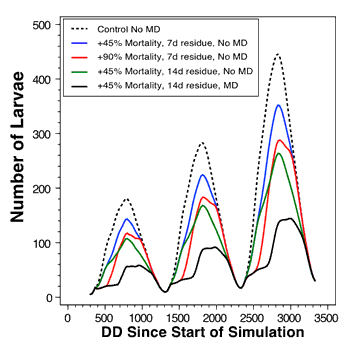
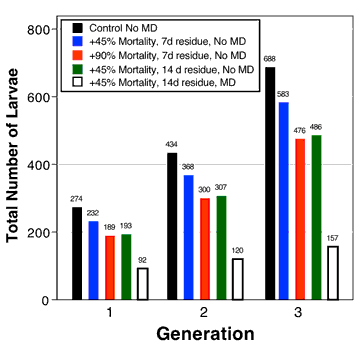
We have completed studies on lure longevity, optimal release rates, trap types, and mixtures versus separate lures, with >65 attractant blends.
This section exceeded the milestones and goals of the grant. Summary and synthesis of this information will continue for the next 1-2 years.
All locations performed field trials using some of our best blends from previous years, and with the addition of acetic acid (AA) or methyl salicylate (MS). Last year, we found that both AA and MS acted to increase trap catch of lacewings, and together were even more powerful. Unlike previous years, we did not use the factorial design because we were limited in resources to test the required number of treatments. The study still enabled us to evaluate how several major taxonomic groups responded to AA, MS, and our previous best blends. We also included several single and two component attractants to help evaluate when simpler lures would work better. The final adjustment this year was a change from the white delta traps to yellow sticky panels. This alteration alone made significant differences in our capture of our key parasitoid groups (results below).

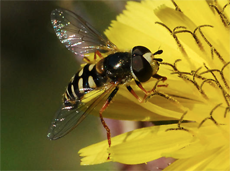
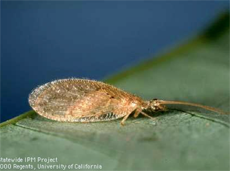
The lacewing Chrysoperla plorabunda responded similarly in apple, pear, and walnut. We found that adding acetic acid to any of the lures increased trap catch compared to the blend without AA present. The best lure was a combination of 2-phenylethanol (PE) + MS + AA, and was statistically better in pear and walnut than the general lure of geraniol (GER) + MS + PE (=GMP) used for our phenology trapping.
The syrphid Eupeodes fumipennis was the most common species caught in California walnuts. Studies there showed that the addition of AA to lures always resulted in a reduction in trap catch. The top four combinations were PE + GER, followed by GMP, acetophenone (AP) + GER, and PE + MS.
In Washington apples, the syrphid diversity was considerably greater than seen in CA walnuts, but overall levels were lower. We found three species of Eupeodes (fumipennis, volucris, and americanus) with the latter two being the most common. In addition, two other genera (Scaeva pyrastri and Syrphus spp.) were also found, but in lower numbers. For the three Eupeodes spp., the top four attractants were the same as found in CA walnuts, and the effect of adding AA was reduced attraction as well.
The brown lacewing, Hemerobius spp., was also frequently caught in CA walnuts. Similar to the syrphid results, addition of AA decreased trap catch with nearly all lures. The best lure was AP + PE, but there were no significant differences between PE + MS or just the MS lure by itself.
Our work is providing effective and simple sampling tools needed by the industry to monitor effects of different management tactics on natural enemies. We have begun providing lures to a small number of pest managers for use in Washington apples. In return, the pest managers will provide us with feedback and help in industry adoption of this technology. We will expand this program to Oregon and California this coming year. Discussions have also begun with several companies regarding potential to manufacture and distribute the lures.
A key to making commercial lures is to make them simple. Our studies to date have used separate lures for each attractant in a blend. With our results from the last three years, we have quantified release rates of 14 different herbivore-induced plant volatiles (HIPVs) through the polyethylene tubing in either direct sunlight or sheltered inside a delta trap. We chose tubing thickness depending on the volatility of the attractant and differences in trap catch. The results of those trials enabled us to pair different attractants that required the same tubing thickness and compare how mixing the attractants together affected trap catch. Our results (Fig. 1) showed no significant differences in trap catch between the combination lure (PE + GER) and the separate lures for all taxa found in significant number: Stethorus, Aphelinus mali, Chrysopa nigricornis, E. volucris or E. americanus. We also saw no significant differences in the MS + AP trial for Stethorus, C. nigricornis, A. mali, and the ichneumonid Glypta.
While each attractant combination should be tested, we expect that no issues will arise with trap catch when mixing attractants together that require the same tubing thickness.
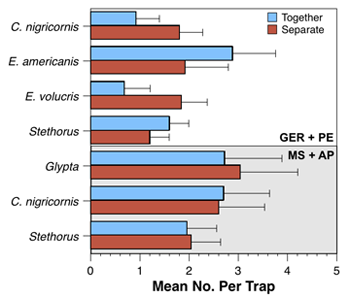
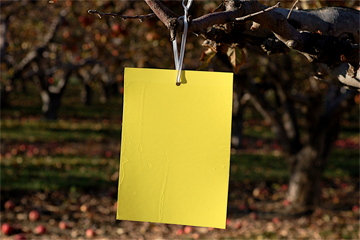
Three parasitoids we consider essential in apple, pear, and walnut are the woolly apple aphid parasitoid, Aphelinus mali, the pear psylla parasitoid Trechnites psyllae, and the walnut aphid parasitoid, Trioxys pallidus. The change to yellow panels from delta traps this past season brought in large numbers of each parasitoid compared to previous years. In the case of T. pallidus, none of the lures improved trap catch over the blank yellow panel. We also found no statistical benefit to adding lures for T. psyllae, although both the GMP and PE + AA + MS lures were roughly 2x higher than the control. For A. mali, the only lure better than the control was PE + GER. Any addition of AA to the lure blend resulted in decreased trap catch. Basically, for “the big 3”, a plain yellow panel is a great monitoring tool (Fig. 2).
Our best lures attract a rich diversity of natural enemies. While useful for evaluating phenology, abundance and diversity of the entire natural enemy complex, this can be a challenge for IPM decision making. Rather than try to make sense of each species, we propose choosing 2-3 and using them as indicator species to estimate the effects of different management tactics and whether the BC of secondary pests is likely. Based on the activity of our attractive blends, their ease of identification, and their abundance in our orchards, we propose to use the squalene lure to monitor C. nigricornis, a PE + MS + AA lure to monitor C. plorabunda, and the AP + GER lure to monitor syrphids in the genus Eupeodes. These different combinations tend to minimize attraction of the other two indicator species and are even more species specific if using orange delta traps for the lacewings (eliminates syrphids) and yellow panels for the syrphids (Fig. 3).

Development of a robust and reliable method for molecular gut content analysis of arthropod CM predators, field collection and evaluation of predators to determine predation rates on codling moth.
This area has progressed extremely well this past year. Sample processing is still in progress but is expected to be finished early in the spring.
Progress has been made in three different areas. First, new primers and reaction conditions have increased the detection sensitivity of codling moth DNA without DNA purification. These results have been verified by sequencing and 100% of the extracts tested showed CM DNA presence. Second, Tom Unruh developed an improved medium for collecting predators in the field that allows a week-long preservation of prey DNA in the predator gut contents. There is some possibility of contamination, but further work is being done using surface sterilization to reduce the contamination issue. To date, the contamination issue does not appear to have affected results as dry-trapped versus wet trapped samples show statistically similar rates of predation. The final area of progress has been accomplished in measuring predation rates and is detailed below.
Studies showed that three groups of arthropods (spiders, ground beetles, and earwigs) tested positive for codling moth DNA between 10.7 and 12% of the time. Predation frequencies did vary between orchard sites sampled, and was related to density of the codling moth. In most commercial orchards, codling moth is relatively rare, so having these levels of predation, combined with the high predator densities that are possible (see below) is indicative of predation pressure on the fifth-instar larvae which are seeking pupation or overwintering sites.

Density measurements of the carabid (ground beetle) predators of CM were made in two orchards. Aluminum flashing was placed in six different areas in each orchard to create a predator enclosure (Fig. 1). Within each enclosure, four pitfall traps were placed at the corners. and the beetles were completely trapped out. In the first orchard, the average density of the ground beetle Pterostichus melanarius, was an astounding 18 beetles/m2, and in the second orchard 6.5/m2. Ground beetles are generalist predators and observations of beetle abundance support our hypothesis that any prey, especially late-instar codling moth larvae on the ground, are at high risk of being attacked. This is particularly valuable in new high density orchards where codling moth larvae tend to cocoon more on the ground than on the tree due to smoother bark.
Spiders were less common in our pitfall traps than ground beetles, but many were collected from trees using beating trays. DNA analysis of the spiders showed that 7 of 13 species fed on CM (Fig. 2) and that predation was dominated by three spider genera: Hololena, Phidippus, and Antrodiaetus.
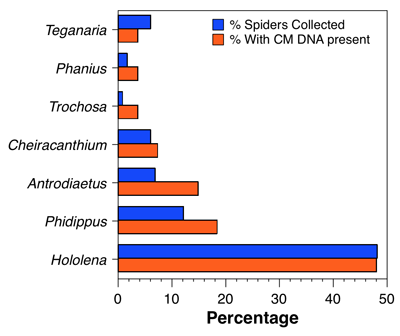
Synthesize information on growers’ willingness to pay for indirect benefits of IPM, develop an expected profit model using enhanced BC and synthesis for use in Objective 6.
This objective is on track to meet the goals and milestones of the grant.
Analyses were conducted on pesticide use data from seven case study orchards to assess the value of natural enemy conservation in pest management. Similar analyses are planned for pear and walnut case study data in 2012. Previous assumptions that IPM programs applying less disruptive OP alternatives (identified in Objective 1) will result in overall lower pest management costs were tested. Comparison of pesticide use in seven case studies implementing different management tactics, material choices, accumulated costs and added costs were examined. In addition, interviews with WA apple and OR pear growers were conducted to assess willingness to pay for different pesticide features.
Evaluating the cost/benefit of biological control is more than simply enumerating how many sprays are saved by conserving natural enemies. The idea of ecosystem services is an important way to assess the value of biological control. If natural enemies are reduced or compromised, then growers are forced to pay to replace the mortality that natural enemies would normally cause. Additionally, if a pesticide has unintended effects on fish or wildlife, then we need to consider those effects as well in the overall cost/benefit analysis.
In our analysis, we used the seven orchard case studies and focused on the pesticides applied, how they affected natural enemies (based on Objective 1 and other studies), and whether pesticides were targeted at aphids or mites, which are frequently considered to be signs of a disrupted management program.
To evaluate how control costs were affected by use of pesticides harsh to natural enemies, we plotted the costs of secondary pest control (aphids, mites) in each orchard against the costs of pesticides that were considered disruptive to natural enemies (Graph 1). We found that for every dollar spent on the application of pesticides disruptive to natural enemies growers spent $0.47 in control costs for secondary pests.
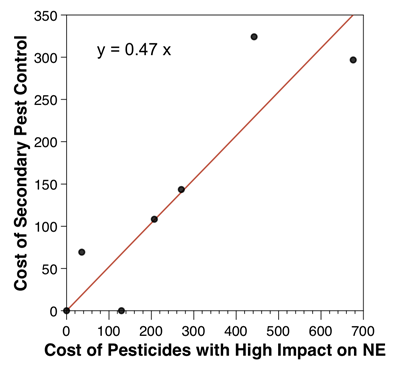
Interviews with Washington apple and Oregon pear growers showed they were willing to pay for increased pesticide effectiveness, but were also willing to pay to preserve natural enemies and fish and wildlife. Apple growers were willing to pay almost $38/acre more for a pesticide that was non-toxic to natural enemies, whereas pear growers were willing to pay $27/acre for a pesticide with no toxicity to fish and and $8/acre for a pesticide with no toxicity to wildlife.
This work illustrates the start of our cost-benefit analysis of capturing the value and benefits of conserving natural enemies in orchards. This coming year we will expand this analysis to a larger number of apple orchards and evaluate similar data sets in pear and walnut orchards. It will provide a framework for cost management decisions based on the ecosystem services provided by the conservation and enhancement of natural enemies.
Use survey results to guide development of educational and outreach programs, synthesize data from completed objectives and implement into management programs, present results to industry.
This section has met and exceeded the goals of the grant in many aspects.
Our group has begun the various outreach programs as information has become available. We have a biological control short course planned in Washington, Oregon, and California for February 2012. We have organized a symposium at the Washington Horticultural Association meeting in December 2011 highlighting project accomplishments and have finished the pear and walnut surveys. Our outreach programs next year will also begin a stronger web presence (highlights below) and a “train the trainer” program that is currently being developed. Summary and synthesis of research information will continue for the next 1-2 years and will be integrated into the educational program as they are completed.
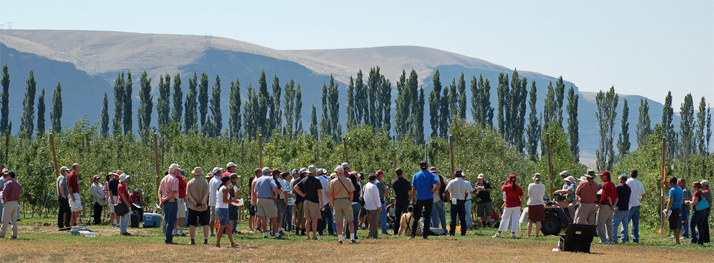
The survey was directed at pear growers and the respondents were overwhelmingly highly educated owners/lessees that relied on consultants to provide IPM advice. However, they clearly made their own decisions a good proportion of the time. Their key sources of information for IPM were fieldmen working for agricultural chemical distributors, the pesticide label, and fieldmen working for the packing house. Secondary sources were formal education or continuing education classes, industry sponsored conferences or workshops, University publications, extension agents, scientists, and other educational workshops. All responders indicated that they monitor insect populations to aid decision making. The data also indicate they use multiple sources of information on insect population monitoring, including themselves (65%), farm employees (20%), or fieldmen working for agricultural chemical distributors (71%), the packing house (33%), and private consultants (10%). (Fig. 1)
Codling moth control is one of the biggest ways pear growers practice conservation biological control. Slightly more than half are using mating disruption for CM control, and they use spot treatments to varying degrees, degree-day models to help time various tactics, tend to choose the least disruptive CM pesticides, and try to time applications to minimize effects on natural enemies (Fig.2). During the last 3 years, there was a nearly 15% increase in the use of BC tactics for those who intentionally try to foster BC practices (Fig. 3). Most of the focus was on conservation BC, but about 20% attempted to enhance NE habitats and 4% released insectary-reared natural enemies.
The Oregon/Washington pear growers commonly use computers (85%) and smartphones (25%) in orchard operations, and 75% regularly access the Internet for farm information. Their preferred sources of information are printed (66%), Internet (56.7%), via email (46.3%), large group in person meetings (45%) or via field days (34%). No other information sources received more than 25% support.
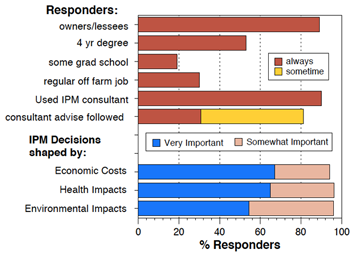
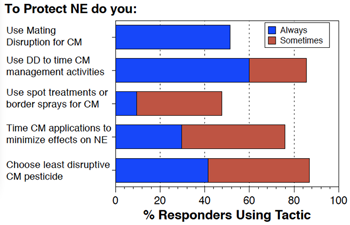
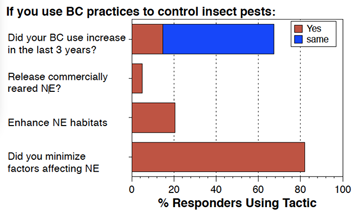
This interactive course will give participants a broad understanding of natural enemies in orchard systems through a mixture of presentations, small group activity sessions, and open discussion.
Information from research supported by the USDA-SCRI grant project focused on enhancing biological control in western apple, pear, and walnut orchards will be highlighted. The course will focus on topics such as using new tools for monitoring natural enemies, the effects of pesticides on natural enemies, and how understanding insect phenology enables us to identify windows of opportunity and develop more BC friendly pest management programs. The information presented in this course is helpful and relevant to most perennial cropping systems. Find more information about our short course at: enhancedbiocontrol.org/BC_SC.html.
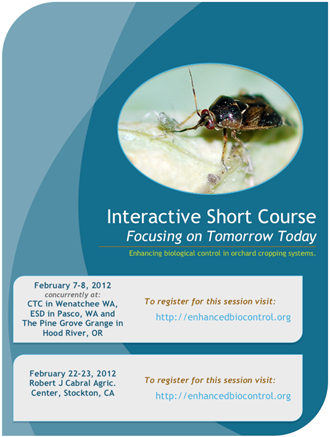

Web-based information transfer must form the basis of our outreach program. Our web site has gone through a major upgrade this year to accommodate an expected large volume of new information. We put nearly 25% of the grant funding towards outreach, and our goal is to leave a legacy of information that is easily accessible for our stakeholders. This coming year, our outreach team will vigorously pursue stories from our researchers, collaborate in the writing of stories, and provide those stories to various traditional University and industry outlets, social media (Facebook, Twitter, YouTube), and the web portals at UC IPM, OSU, and WSU. We also purchased the URL enhancedbiocontrol.org to simplify searches. Expect a large increase in new information being added starting this coming year.
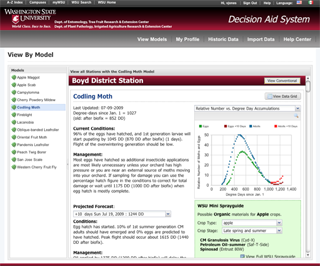
WSU-DAS is the flagship product for IPM decision making in Washington tree fruit. A survey of apple IPM consultants in 2010 by the Pest Management Transition Program showed they considered DAS to be the most important information source of IPM information. In the past four years, it has gone from a beta system with 12 users to roughly 300 regular users. Those three hundred estimate they directly make decisions on 80% of the 225,000 acres of tree fruit in Washington State. DAS allows us to share in real time information on IPM tactics, models of pests and natural enemies, pesticide choices that minimize natural enemy mortality, and provide timely stories important for IPM decision makers. Our work in the enhanced BC grant will be integrated into this system as the research is completed and will be spread to the other states as it is developed. An iPhone version is available! das.wsu.edu
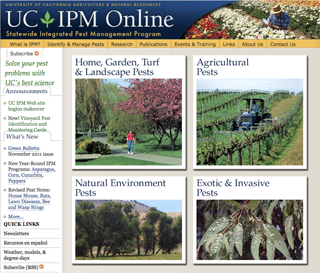
UC IPM Online presents IPM information for urban, agricultural, and natural resource areas. Use the Natural Enemies Gallery to learn about life cycles and identification. In agricultural crops, learn about natural enemies and their role in biological control by visiting the Pest Management Guidelines. Information about the toxicity of some pesticides to natural enemies is presented in the guidelines for each crop. Toxicity to natural enemies is also presented for urban pesticides and discussed in several related resources on biological control. The information generated by the enhanced BC grant will be integrated into UC IPM Online through these resources and will be useful for both of our urban and agricultural clientele.